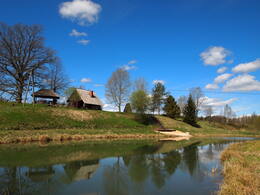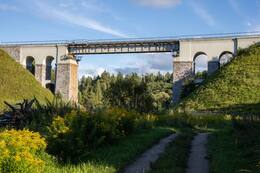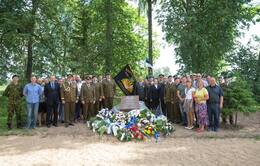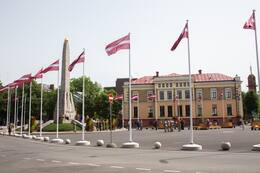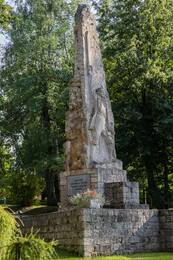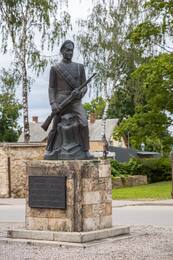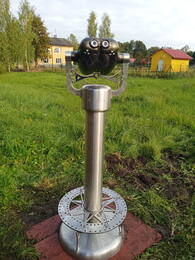Cėsių mūšių pėdsakais
Diena 1.
153 km
Ryga – Amata – Skangaliai – Cėsis
Praktinė informacija
- Važiavimo atstumas: 153 km
- Ekskursijos ir piknikai „Miško mūšiuose“ su gidu, tik iš anksto užsiregistravus
- Geležinkelio tiltas per Raunos upę geriausiai matomas iš dešinės Cėsių–Valmieros plento pusės. Jį galima pamatyti tik iš tolo.
Lankytinos vietos
poilsio vieta „Miško mūšis“ (Meža kaujas) – Cėsių mūšių svarbiausios veiksmo vietos prie Amatos tilto
Poilsiavietė, pavadinta „Miško mūšiais“, yra pagrindinėje Cėsių mūšių vietoje, netoli Amatos tilto. Lankytojai gali klausytis pasakojimų apie Cėsių mūšius ir dalyvauti įvairiose veiklose, įskaitant žygius pėsčiomis ir išvykas po svarbiausias Cėsių mūšių vietas bei komandines kovas. Pabaigoje lankytojai gali mėgautis gaivinančia karo meto sriuba. Geležinkelio tiltas per Amatą atliko labai svarbų vaidmenį visame Nepriklausomybės kare, nes čia įvyko pirmieji Estijos armijos susidūrimai su Landesveru. 1919 m. birželio 5 d. prie geležinkelio tilto per Amatą įvyko pirmasis Estijos armijos šarvuočių mūšis su Baltijos landesvero daliniais. Landesveras, žinodamas, kad artėja šarvuotasis traukinys, užminavo geležinkelio tiltą ir užėmė pozicijas Amato sodyboje ant upės kranto, ruošdamasis galimam mūšiui. Tiltas per Amatą žymėjo sieną tarp Estijos pajėgų ir vokiečių. 1919 m. birželio 23 d. naktį, per Cėsių mūšius, landesveras paliko Cėsius ir atsitraukė iki Amatos upės ribos. Atsitraukdami vokiečiai sudegino Cėsių latvių draugijos namus ir susprogdino tiltą per Amatą.
Siūloma unikali galimybė stebėti 1919 m. birželio 5 d. įvykius per virtualios realybės akinius.
Geležinkelio tiltas per Raunos upę
Geležinkelio tiltas per Raunos upę yra netoli P20 greitkelio, Priekulių valsčiuje. Jį galima apžiūrėti iš dešinės Cėsių–Valmieros greitkelio pusės. Geležinkelio tiltas nėra skirtas pėstiesiems ir yra stebimas apsaugos darbuotojų. Pastatytas 1889 m., mūrinis tiltas Rygos–Valkos geležinkelio linijoje yra aukščiausias tokio tipo geležinkelio statinys Baltijos šalyse. Jo aukštis – 24 metrai, o ilgis – 78,9 metrai. Traukiniai, ypač sunkūs krovininiai traukiniai, privalo važiuoti 80 km/h greičiu. Didesni greičiai tiltu neleidžiami. Tačiau važiuojant mažesniu greičiu traukinys negali įveikti nedidelio tilto nuolydžio abiejose pusėse ir gali pradėti slysti atgal. 1919 m. birželį, per Estijos ir Latvijos nepriklausomybės karus, per tiltą iš Valkos, kuri buvo fronto gale, geležinkeliu buvo išsiųstas Estijos armijos pastiprinimas, tarp kurio buvo ir Šiaurės Latvijos brigada. Kai 2-asis Cėsių pėstininkų pulkas buvo priverstas trauktis iš Cėsių, jo daliniai sustiprino savo pozicijas Raunos upės pakrantėse. Geležinkelio tiltas tapo įtvirtinimų dalimi ir užtikrino Estijos šarvuočių judėjimą mūšių metu. Antrojo pasaulinio karo metu, 1941 m. liepos 4 d., tiltą susprogdino bėganti Raudonoji armija, kai sovietų okupaciją Latvijoje pakeitė vokiečių okupacija. Vokietijos armijos saperiai per savaitę atstatė tiltą. Po Antrojo pasaulinio karo, sovietų okupacijos metu, tiltas per Rauną turėjo karinę strateginę reikšmę ir buvo griežtai saugomas.
Memorialas Skangalių dvare
Jungtinės Latvijos ir Estijos kariuomenės pergalės mūšyje dėl Skangalių dvaro paminklas yra maždaug už 20 kilometrų nuo Cėsių. Atminimo akmuo, skirtas Cėsių mūšių dalyviams ir Estijos Kalevlaste Malevos bataliono kovotojams, buvo atidengtas 2019 m. birželio 22 d. Jungtinės Latvijos ir Estijos kariuomenės pergalė mūšyje dėl Skangalių dvaro, kuris įvyko čia, buvo lūžio taškas Cėsių mūšiuose, dėl kurio Niedros vyriausybės kariuomenė pradėjo visuotinį atsitraukimą. Andrijevo Niedros vyriausybė buvo laikina provokiška Latvijos vyriausybė, egzistavusi nuo 1919 m. gegužės 10 d. iki birželio 26 d. Puolimas prieš Landesvero dalinį prasidėjo 1919 m. birželio 22 d. ankstų rytą, kai 3-ioji Kalev kuopa, panaudojusi šarvuotį, įsiveržė į Skangalių dvarą ir užgrobė 2 patrankas, tačiau priešas vis tiek perėjo į kontrataką. Šiek tiek vėliau, vidury dienos, kariuomenė pakartojo ataką, ir po įnirtingos artimos kovos Landesvero dalinys buvo išstumtas iš Skangalių dvaro. Tarp mūšio trofėjų – kulkosvaidžiai, didelis kiekis šaudmenų ir kitos kovinės įrangos. Po dviejų valandų estai užėmė svarbią kelių sankryžą prie „Starti“ užeigos. Mūšyje užimant Skangalių dvarą buvo sužeisti arba žuvo 58 „Kalev“ kareiviai. Estija suteikė didelę paramą įrengiant memorialinę vietą.
Pergalės paminklas Cėsyse
Pergalės paminklas latviams ir estams, žuvusiems Cėsių mūšiuose, yra Cėsių mieste, Vienybės aikštėje. Pagerbiant 1919 m. Cėsių mūšių dalyvius, 1924 m. birželio 22 d., už gyventojų paaukotas lėšas, pagal architekto Paulo Kundzinio eskizą buvo padėtas pirmasis Pergalės paminklo akmuo. Sovietų okupacijos metu, 1951 m. kovo 25 d. naktį, paminklas buvo susprogdintas ir visiškai nugriautas. Nuo 1959 iki 1990 m. buvusioje Pergalės (Vienybės) aikštėje stovėjo skulptoriaus Kārlio Jansonso sukurtas Lenino paminklas. 1997 m. Cėsių rajono tarybos pirmininkas Māris Niklass sugebėjo įtraukti Estijos valstybės institucijas į paminklo restauravimą. Paminklo statybai reikalinga medžiaga – Saremos dolomitas – buvo gauta dovanų iš Estijos. 1998 m. birželio 22 d., minint 79-ąsias Cėsių mūšių metines, Vienybės aikštėje buvo padėtas pirmasis restauruojamo paminklo akmuo. Atkurto Pergalės paminklo atidengimo ceremonija Cėsyse įvyko 1998 m. lapkričio 15 d. (autorius: architektas Imants Timermanis). Informacijos apie Pergalės paminklą galima rasti Cėsių istorijos ir meno muziejaus ekspozicijoje „Cėsys ir Latvijos nepriklausomybės karas“, esančioje Naujojoje pilyje.
Paminklas Cėsių mūšiams atminti
Paminklas Cėsių mūšiuose žuvusiems estų ir latvių kariams yra Priekulių savivaldybėje, Liepoje, maždaug 1 kilometrą į pietus nuo Lodės geležinkelio stoties, Rūpnīcas gatvės pusėje. Pirmasis paminklo akmuo buvo padėtas 1929 m. rugsėjo 22 d., o paminklas atidengtas 1935 m. rugpjūčio 11 d. Paminklas, sukurtas pagal skulptoriaus Augusto Jullos, gyvenusio Julose, Liepos parapijoje, eskizą iš Allažių kaimo kalkakmenio, yra aukštražis valstiečio kareivio, viena ranka besiremiančio į plūgą, o kita – pakeltu kardu, atvaizdas. Skulptūros veidui sukurti panaudota skulptoriaus tėvo Janio Jullos mirties kaukė. Pasak Liepos parapijos istorijos tyrinėtojo Aivaro Vilnio, žvelgiant į paminklą iš paukščio skrydžio, matyti, kad jo pagrindas, takas ir laiptai, vedantys prie paminklo, sudaro strėlės, nukreiptos į Liepos dvarą (Lindenhoff) vokiečių pozicijų Cėsių mūšių kryptimi, formą. Žinoma, kyla abejonių, ar tai iš tikrųjų buvo autoriaus sumanymas tuo metu, tačiau tai neabejotinai praturtina mūsų šiandieninę paminklo interpretaciją. Šalia paminklo yra vienintelės Latvijoje natūralios smiltainio arkos, žinomos kaip „Lielā Ellīte“ („Liepas Ellīte“ arba Velnio krosnis).
Paminklas Cėsių pulko studentams
Paminklas Cėsių pulko studentų kuopos kariams, žuvusiems Cėsių mūšiuose, yra Cėsių mieste, netoli Palasta ir Bērzaines gatvių sankryžos. Paminklo statybą pasiūlė Cėsių pulko studentų kuopos karių asociacija. Paminklas buvo atidengtas 1938 m. gegužės 26 d. Paminklas sukurtas pagal buvusio kuopos kario, dailininko Jānio Rozenbergo, eskizą. Ant metro aukščio kalkakmenio pjedestalo pastatytą 1,8 metro varinę skulptūrą, vaizduojančią karį, vilkintį moksleivio uniformą, sukūrė skulptorius Rūdolfs Āboltiņš ir varkalys Jānis Zibens. Prie kareivio kojų tupi pelėda – išminties ir žinių simbolis, gindama į karą išėjusio studento knygas. Skulptūra buvo nugriauta per pakartotinę sovietų okupaciją 1952 m. 1957 m. netoli buvusios jos vietos buvo pastatytas skulptoriaus Kārlio Jansonso sukurtas paminklas „Komjaunimo vėliavnešys“. Pastatytas netoli istorinės vietos, restauruotas paminklas buvo atidengtas 1992 m. lapkričio 11 d. Tuo pačiu metu, 1992 m., buvo nugriautas okupacinio režimo pastatytas komjaunimo paminklas.
Virtualios realybės žiūronai „Cėsių mūšis“
Cėsių mūšis buvo vienas reikšmingiausių lūžio taškų Latvijos Nepriklausomybės karo (1918–1920 m.) eigoje. 1919 m. birželio 5 d., susidūrus Estijos armijos šarvuotiems traukiniams ir Landesvero daliniams netoli Ierikių geležinkelio stoties, prie tilto per Amatą, prasidėjo pirmasis Cėsių mūšio etapas. Šio įvykio atminimui netoli Ierikių stoties sukurtas turistinis objektas, siūlantis patirti istorijos istoriją, pasitelkiant šiuolaikinių technologijų galimybes – virtualios realybės pagalba. Penkių minučių trukmės vaizdo įrašą „MŪŠIS PRIE TILTO PER AMATĄ“ galima nemokamai peržiūrėti kiekvieną dieną virtualios realybės žiūronuose. Vaizdo įrašo trukmė: 5 min., LV su subtitrais LV, ENG, EST ir ES kalbomis.
Vietos pavalgyti
The Lake Castle of Āraiši
The Lake Castle of Āraiši is of pan-European importance. It is a reconstructed Lettigalian lake castle from the 9th or 10th century, and it is the only place in the Baltic States at which visitors can learn about how people lived more than 1,000 years ago. The castle offers various thematic events.
Cėsiuose turisms.cesis.lv/en/kur-pavalgyti/
Vietos apsistoti
Skangaļi manor
The manor is located in a quiet and peaceful center of Vidzeme, Priekuli district, between Cesis and Valmiera. In the main building of the manor there is a guest house, which has a kitchen with a dining room, lounge, guest bedrooms and a conference hall. A sauna can be be booked on request. There is a pond, a fireplace and a barbecue.
In the cozy dining room of the manor you can enjoy a meal prepared by skilled chefs. Guests will find refrigerator, kettle, microwave, toaster available. We offer home-grown seasonal vegetables, fruits and berries.
There is an exposition in the former barn building of Skangaļi manor, where you will learn about the history, present and future plans of the manor in the guide's story and during the tour of the manor complex. In the season / May-October / opportunity to see an exhibition of works of art.
Apaļkalns
Cėsiuose turisms.cesis.lv/en/kur-apsigyventi/




